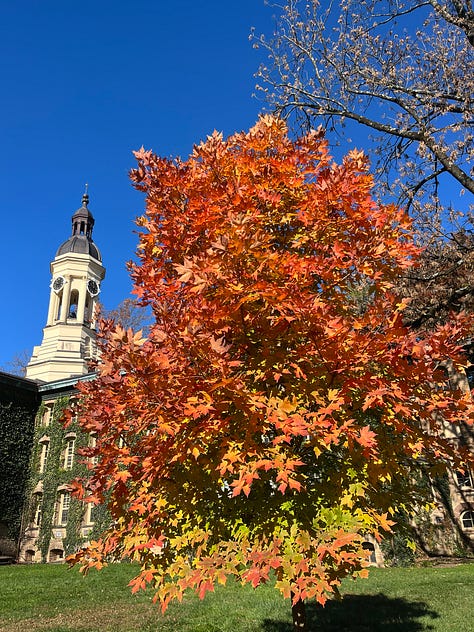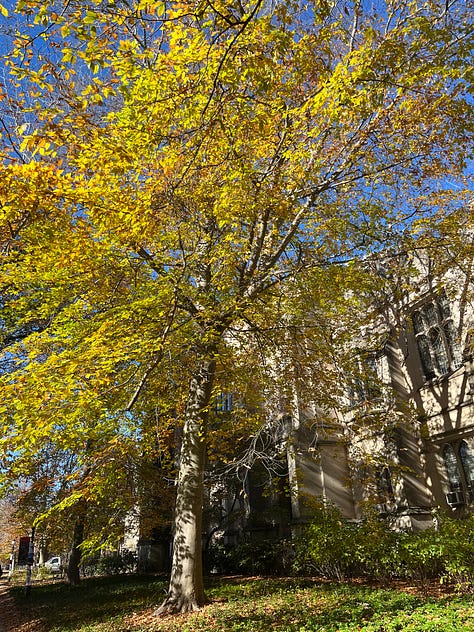In daylight, I discovered that Princeton is not like Cambridge at all. In some ways, it’s much more beautiful - the UK could certainly never compete with the fall foliage here. In other ways, it’s simply more American. It’s certainly more posh. There is a long road that stretches southwest out of town, lined by large houses, that leads to Einstein Drive. This is where the Institute for Advanced Study (IAS) is located. The IAS was founded as a centre for theoretical research (no dirty labs here!) in 1930 and is independent of Princeton University. In the 1930s, when many eminent Jewish scientists were leaving Europe, the IAS provided a new intellectual (and physical) home: Einstein, Weyl, Von Neumann, Godel and so on. There, I met my editor, Diana Gillooly, for lunch.



The cafeteria at the IAS is loud, bustling and full of mathematicians. We queued for food, Diana greeting people we bumped into, and then settled down at a small table for two. Next to us were a few long tables “Those two tables are for mathematicians. That one is for physicists. And on that small one at the back are the art historians” Diana told me. Quite unlike Bell Labs, people tend to stick to their own here! After lunch, we walked over to the IAS archives, to meet the archivist who’s currently in touch with researchers working on Indian scientists at Bell Labs. While we were there, she pointed out a recent exhibition they had put together (that we didn’t have time to see) and gave us copies of George Dyson’s book “Turing’s cathedral” on the history of computing. George Dyson had spent his childhood in the 1950s at the IAS, with his father the physicist Freeman Dyson. In that time, he had played in with the other kids in the barn which had leftover bits of equipment from the computer built by John Von Neumann in the 1940s. The building that housed the computer now hosts the IAS daycare centre.


From the IAS we headed back into town to the Princeton University Press building - located right in the middle of the University. The building has a beautiful courtyard at the entrance, with strikingly colourful plants. Inside, we met the sales and marketing director, who gave me some insight into the process of publicising books. And then it was time for my work-in-progress talk. When I first was planning the trip, I wasn’t sure whether Princeton would be a stop at the beginning or the end of my journey. I’m so glad it came after 10 incredible days of interviews. Right now I’m buzzing with ideas and enthusiasm and it felt like the right time to share my work. There were lots of questions, which is always nice, and I feel has further fuelled my excitement about the book. When I got back to the hotel, I knew I deserved a nice cup of tea and a biscuit. I asked the receptionist if I could have some hot water and milk. I was somewhat trepidatious, as I’d asked for hot water last night and had been given a disposable cup - tea doesn’t taste the same in paper. When she emerged from the kitchen carrying a tray complete with a teapot, a cup and saucer and a little jug of milk, I could have cried for joy. Definitely a well-deserved cup of tea.




Reading on Princeton University has reminded me of the movie ‘A Beautiful Mind’.
On another note: tea doesn’t taste the same in a paper cup - so rightly said.
That IAS cafeteria sounds like it's straight out of every movie made about the American high school experience.